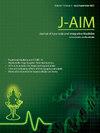评估瑜伽和自然疗法专业人员的工作健康和福祉:来自印度的横断面研究
IF 1.9
Q3 INTEGRATIVE & COMPLEMENTARY MEDICINE
引用次数: 0
摘要
背景:卫生工作者在其职业环境中面临重大危害。虽然许多研究记录了传统卫生保健工作者的健康风险,但CAM卫生工作者面临着独特的挑战,包括重复性工作带来的身体压力和密集的患者互动带来的社会心理压力。尽管瑜伽和自然疗法在印度和全球范围内广泛应用,但缺乏关于瑜伽和自然疗法卫生工作者的职业健康和福祉的报告。目的:本研究旨在通过探索瑜伽和自然疗法专业人员的职业健康问题和幸福感来填补这一空白,为改善他们的工作环境和支持系统提供有价值的见解。方法:在印度一家以瑜伽和自然疗法为基础的生活方式医学医院进行横断面研究。参与者包括医生、实习生、治疗师、司机,以及至少有一年工作经验的行政、厨房和家政人员。总体幸福感、生活质量、疲劳和工作倦怠的数据通过有效的问卷收集。数据分析采用单变量和多变量方法来计算患病率,并确定与倦怠、疼痛和职业症状相关的因素。结果:138名参与者中,女性占68.1%,治疗师占34.1%。大多数参与者都超重或肥胖。29%的人报告了高倦怠水平,眼睛疲劳(41.3%)和睡眠障碍(26.8%)是普遍的职业健康问题。女性和有六年工作经验的人出现职业症状和倦怠的几率更高。结论:大多数人认为工作场所是安全的,没有性骚扰的报告。这项研究强调需要有针对性的干预措施,以改善职业健康和福祉的瑜伽和自然疗法卫生工作者。未来的研究应该包括更大、更多样化的样本,以验证和扩展这些发现。本文章由计算机程序翻译,如有差异,请以英文原文为准。
Assessing the work-related health and well-being of yoga and naturopathy professionals: A cross-sectional study from India
Background: Health workers face significant hazards in their occupational settings. While many studies document the health risks of conventional healthcare workers, CAM health workers encounter unique challenges, including physical strain from repetitive tasks and psychosocial stressors from intensive patient interactions. Despite the widespread practice of yoga and naturopathy in India and globally, there is a lack of reports on the occupational health and well-being of yoga and naturopathy health workers. Objectives: This study aims to fill this gap by exploring the occupational health issues and well-being of yoga and naturopathy professionals, providing valuable insights to improve their work environments and support systems. Methods: A cross-sectional study was conducted in a yoga and naturopathy-based lifestyle medicine hospital in India. Participants included doctors, interns, therapists, drivers, and administrative, kitchen, and housekeeping staff with at least one year of work experience. Data on general well-being, quality of life, fatigue, and work-related burnout were collected using validated questionnaires. Data analysis involved univariate and multivariate approaches to compute prevalence and identify factors associated with burnout, pain, and occupational symptoms. Results: Among 138 participants, 68.1% were female, and 34.1% were therapists. Most participants were overweight or obese. High burnout levels were reported by 29%, with eye strain (41.3%) and sleep disturbances (26.8%) being prevalent occupational health issues. Females and those with up to six years of experience had higher odds of occupational symptoms and burnout. Conclusions: The majority perceived the workplace as safe, with no reports of sexual harassment. This study highlights the need for targeted interventions to improve the occupational health and well-being of yoga and naturopathy health workers. Future research should include larger, more diverse samples across multiple settings to validate and expand upon these findings.
求助全文
通过发布文献求助,成功后即可免费获取论文全文。
去求助
来源期刊

Journal of Ayurveda and Integrative Medicine
INTEGRATIVE & COMPLEMENTARY MEDICINE-
CiteScore
4.70
自引率
12.50%
发文量
136
审稿时长
30 weeks
 求助内容:
求助内容: 应助结果提醒方式:
应助结果提醒方式:


